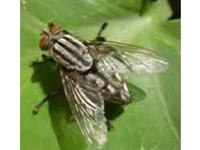Confused Flour Beetle (Also see Rust-Red Flour Beetle)
Granary Weevil (Also see Rice Weevil)
Mediterranean Flour Moth or Mill Moth
Red-legged Ham or Copra Beetle
Rice Weevil (Also see Granary Weevil)
Rust-Red Flour Beetle (Also see Confused Flour Beetle)
Tropical Warehouse or Almond Moth (Also see Warehouse, Tobacco or Cocoa Moth)
Warehouse, Tobacco or Cocoa Moth (Also see Tropical Warehouse or Almond Moth)

Appearance
Adult : Gray with three dark stripes on the thorax and checkerboard pattern on grey abdomen; 10-12 mm long, with females usually larger than males.
Life Cycle
Some species lay eggs while some give birth to live young on sources of food such as carrion, dung or decaying material and even open wounds on animals. Larvae are whitish maggots, which feed for 5-7 days before burrowing into the soil to pupate.
Notes
Can carry leprosy bacilli and transmit intestinal pseudomyiasis to people who eat meat containing the larvae. When maggots develop in open wounds in animals, they can cause myiasis and blood poisoning or asymptomatic leprosy infections. Maggots collected from human corpses have been used as a tool in forensic entomology investigations to calculate the approximate date of death (since the flesh fly's life cycle is well documented and predictable) and this evidence has often helped in solving murder cases.

